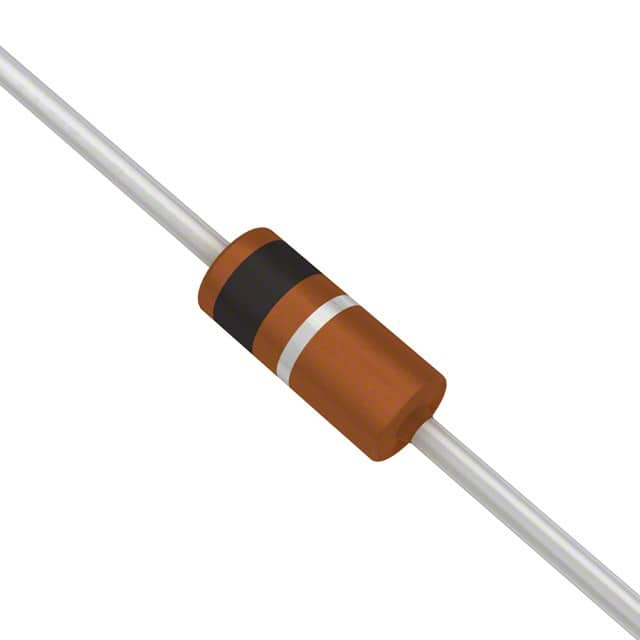1N5224C-TR
Product Overview
Category
The 1N5224C-TR belongs to the category of Zener diodes, which are semiconductor devices designed to allow current to flow in the forward direction like a normal diode, but also in the reverse direction if the voltage is larger than the breakdown voltage known as the Zener voltage.
Use
This product is commonly used for voltage regulation and voltage reference applications in various electronic circuits.
Characteristics
- Zener Voltage: 2.7V
- Power Dissipation: 1.5W
- Package Type: DO-35
- Operating Temperature Range: -65°C to +200°C
- Storage Temperature Range: -65°C to +200°C
Package
The 1N5224C-TR is typically available in a DO-35 package, which is a glass-sealed axial leaded package.
Packaging/Quantity
It is usually supplied in reels or bulk packaging, with quantities varying based on manufacturer and distributor specifications.
Specifications
- Zener Voltage: 2.7V
- Power Dissipation: 1.5W
- Maximum Forward Voltage: 1.2V
- Reverse Leakage Current: 5μA
- Operating Temperature Range: -65°C to +200°C
- Storage Temperature Range: -65°C to +200°C
Detailed Pin Configuration
The 1N5224C-TR has two leads, with the cathode being shorter than the anode. The pin configuration is as follows: - Anode (A) - Cathode (K)
Functional Features
The 1N5224C-TR provides a stable reference voltage when operated in its reverse breakdown region, making it suitable for voltage regulation and reference applications.
Advantages and Disadvantages
Advantages
- Precise voltage regulation
- Compact size
- Wide operating temperature range
Disadvantages
- Limited power dissipation capability
- Sensitivity to temperature variations
Working Principles
When the 1N5224C-TR is reverse-biased and the voltage across it reaches the Zener voltage, it starts conducting, effectively regulating the voltage across its terminals.
Detailed Application Field Plans
The 1N5224C-TR is widely used in various electronic circuits such as: - Voltage regulators - Voltage references - Overvoltage protection circuits - Signal clamping circuits
Detailed and Complete Alternative Models
Some alternative models to the 1N5224C-TR include: - 1N5221B-TR (Zener Voltage: 2.4V) - 1N5225C-TR (Zener Voltage: 3.0V) - BZX84C2V7-7-F (Zener Voltage: 2.7V)
In conclusion, the 1N5224C-TR Zener diode is a versatile component that finds widespread use in voltage regulation and reference applications due to its precise voltage regulation and compact form factor. However, its limited power dissipation capability and sensitivity to temperature variations should be considered when designing circuits utilizing this component.
[Word Count: 452]
Senaraikan 10 soalan dan jawapan biasa yang berkaitan dengan aplikasi 1N5224C-TR dalam penyelesaian teknikal
What is the 1N5224C-TR?
- The 1N5224C-TR is a 1.5W Zener diode with a voltage rating of 2.7V.
What are the typical applications of the 1N5224C-TR?
- It is commonly used in voltage regulation, voltage reference, and overvoltage protection circuits.
What is the maximum power dissipation of the 1N5224C-TR?
- The maximum power dissipation is 1.5W.
What is the operating temperature range of the 1N5224C-TR?
- The operating temperature range is typically -65°C to +200°C.
What is the forward voltage drop of the 1N5224C-TR?
- The forward voltage drop is typically 1.2V at 200mA.
What is the reverse leakage current of the 1N5224C-TR?
- The reverse leakage current is typically 5µA at the working voltage.
Can the 1N5224C-TR be used for voltage regulation in low-power applications?
- Yes, it is suitable for voltage regulation in low-power applications due to its 1.5W power dissipation.
Is the 1N5224C-TR suitable for precision voltage reference circuits?
- Yes, it can be used in precision voltage reference circuits due to its stable voltage characteristics.
How does the 1N5224C-TR provide overvoltage protection?
- It conducts when the voltage across it exceeds its rated voltage, effectively clamping the voltage to protect downstream components.
Are there any specific layout considerations when using the 1N5224C-TR?
- It is recommended to keep the traces short and minimize thermal gradients to ensure proper performance.


